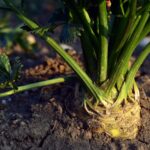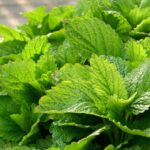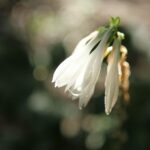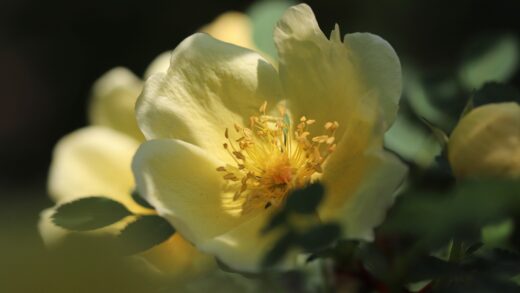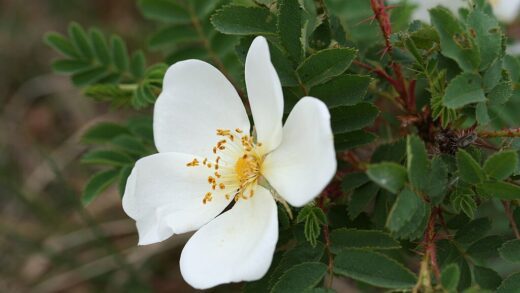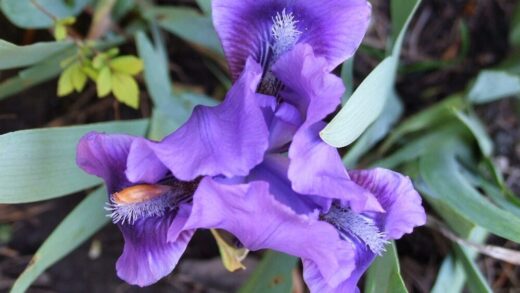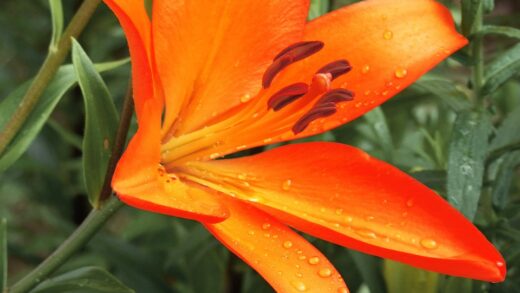The African Daisy, also known as the Cape Marigold or Dimorphotheca, is an annual plant of impressive beauty, native to South Africa, that can радовать any garden with its vibrantly colored flowers. However, for this sun-loving plant to shine in its full glory, it is essential to accurately know its water needs and to establish a correct watering practice. Although it is considered a drought-tolerant species, especially younger specimens and plants in their flowering period appreciate careful water supply. The purpose of this article is to provide a detailed guide for the optimal watering of the African Daisy, taking into account the plant’s physiological peculiarities and environmental factors.
The Natural Habitat as a Guideline
The homeland of the African Daisy is Namibia and the western and northwestern regions of South Africa, where summers are hot and dry, and winters are mild and rainier. This origin fundamentally determines the plant’s ability to tolerate drought; it developed in areas where adaptation to water scarcity is crucial for survival. As a result, it develops a deep root system with which it can absorb moisture even from deeper soil layers. It can be observed that in its natural habitat, the plant is often found on sandy, well-drained soils, which is also an important aspect when growing it in the garden.
The study of the natural rainfall distribution reveals that the African Daisy’s active growth and flowering period often coincides with the rainier winter months, while the hot, dry summer period is characterized by a sort of dormancy or less intensive growth phase. Under garden conditions, however, where we aim for abundant flowering during the summer months, we can ensure the necessary moisture through watering. Therefore, based on the habitat conditions, we can conclude that the plant does not require constantly moist soil, and in fact, standing water can be extremely harmful to it.
In its native ecosystem, the African Daisy often grows in company with other drought-tolerant plants with similar requirements. This environment contributes to maintaining soil moisture and balancing the microclimate. The slightly hairy or waxy surface of the plant’s leaves also serves to reduce evapotranspiration, which is an additional adaptation to an environment with water scarcity. Knowledge of these properties helps to understand why it prefers moderate watering instead of an excessive amount of water.
It is therefore important to emphasize that, although we create different conditions when growing in the garden, the plant’s innate characteristics must be taken into account. Excessive care, especially overwatering, is much more likely to cause problems than a temporary, slight water shortage. The goal is to establish a watering regime that mimics the natural rainfall pattern without stressing the plant, while also maximizing flower production.
More articles on this topic
The Critical Role of Soil Quality
In the water management of the African Daisy, a key factor is the soil structure and its drainage capacity. The plant distinctly prefers loose, well-aerated, sandy, or loamy soils that are not prone to waterlogging. If the soil is too compact and clayey, the roots can easily become oxygen-deprived, leading to root rot and the plant’s demise. Therefore, before planting, it is advisable to prepare the soil thoroughly, improving its structure if necessary by adding sand, compost, or perlite.
Ensuring good drainage is not only important for preventing root rot but also because it allows the roots to penetrate deeper in search of moisture. This results in stronger, more resilient plants that better tolerate temporary drought. If water drains quickly from the upper layers, the plant is forced to send its roots deeper, which is beneficial for it in the long run. Conversely, a constantly moist surface encourages root development near the surface, which makes the plant more vulnerable.
The soil’s pH value can also influence water absorption, although the African Daisy is relatively tolerant in this regard. Generally, neutral to slightly acidic soils (pH 6.0-7.0) are the most ideal for it. At extreme pH values, nutrient absorption can be impaired, which can indirectly affect the plant’s water balance as well. A soil analysis can help determine the pH value and make necessary corrections.
When growing in pots, special attention must be paid to selecting the appropriate planting medium. It is recommended to use high-quality, loose potting soil that contains sand or perlite to improve drainage. The presence and permeability of drainage holes at the bottom of the pots are essential so that excess water can drain freely. A layer of expanded clay or gravel at the bottom of the pot can further improve drainage, preventing the roots from standing in water.
More articles on this topic
Basic Principles of Watering: When and How?
The basic rule for watering the African Daisy is to water less frequently but more thoroughly, rather than often and in small amounts. This encourages the plant to develop a deeper root system, which increases its drought tolerance. Between waterings, the top few centimeters of the soil should be allowed to dry out. This can be easily checked with a finger: if the soil feels dry to a depth of 2-3 cm, then it is time to water.
The amount of water administered should be sufficient to moisten the soil throughout the entire depth of the root zone. In the case of planting in open ground, this means that the soil should be noticeably moist to a depth of at least 15-20 cm after watering. Potted plants are watered until the water begins to drain from the drainage holes at the bottom of the pot. However, excess water should always be removed from the saucer so that the pot does not stand in water.
The ideal time for watering is early in the morning or late in the afternoon, towards the evening. At these times, evaporation losses are lower, and the plant has enough time to absorb the water before the strong sun or cooler night temperatures arrive. Water should, if possible, not touch the leaves, especially during midday hours, as water droplets can act as lenses and cause burns, and moist foliage promotes the development of fungal diseases.
Environmental factors significantly influence the watering needs. In hot, windy, sunny weather, plants require more water, while on cooler, cloudy, humid days, the watering frequency can be reduced. Natural rainfall must also be taken into account; after a heavy rain, additional watering may not be necessary for several days. Flexibility and attention to the plant’s signals are crucial for successful water supply.
Water Needs in Different Developmental Stages
After sowing and for young seedlings, keeping the soil moist is extremely important for successful germination and initial root development. At this stage, the soil surface should not be allowed to dry out completely, but overwatering should be avoided. Even moisture can be ensured by fine spraying or careful watering. As soon as the seedlings strengthen and a few true leaves appear, they can be gradually accustomed to less frequent but more thorough watering.
Newly planted young plants also need more regular water supply during the first few weeks, until their root system is properly established in its new location. During this period, soil moisture should be checked more frequently and watered as needed, especially in drier weather. A thorough watering at planting helps to establish good contact between the roots and soil and to eliminate air pockets.
Mature, well-rooted African Daisies tolerate drought much better. At this stage, allow the top layer of soil to dry out thoroughly between waterings. Excessive water supply at this phase can lead to weaker flowering and increased susceptibility to diseases. However, during the plant’s flowering period, care should be taken that it does not suffer from prolonged water shortage, as this can lead to a reduction in flower size and a shortening of the flowering period.
After the peak of flowering, as the plant approaches the end of the season, its water needs may naturally decrease. If the goal is seed collection, moderate water supply should continue to be provided, but if only seasonal decoration is important, the watering frequency can be further reduced. With the onset of autumnal, cooler, and rainier weather, watering can usually be reduced to a minimum or even stopped completely, especially for plants in open ground.
Signs and Consequences of Overwatering and Underwatering
Overwatering is one of the most common mistakes in cultivating the African Daisy and can cause serious problems. The most obvious sign is the yellowing of the leaves, especially starting from the lower leaves, as well as a general wilting of the plant, even though the soil is moist. This happens because the roots in a constantly wet environment do not receive enough oxygen and begin to rot. As a result of root rot, the plant cannot absorb water and nutrients, which eventually leads to its death.
Other signs of overwatering can be soil with an unpleasant, musty odor, or the appearance of mold on the soil surface or on the side of the pot. The absence of flowering or the dropping of buds can also indicate excessive water supply. Growth slows down, and the shoots may become weak and thin. If such symptoms are observed, watering must be stopped immediately, and the soil must be allowed to dry out thoroughly. In severe cases, it may be necessary to repot the plant into fresh, drier medium after removing the rotten root parts.
Underwatering, although the African Daisy tolerates drought relatively well, can also cause problems, especially in the case of prolonged water shortage. The primary symptom is the wilting of the leaves, their limpness, and later the browning and drying of the leaf edges. The plant’s growth slows down, the flowers may be smaller, and the flowering period may be shortened. In severe cases, the leaves dry out completely and fall off, and the buds do not open.
If signs of underwatering are observed, a thorough, deep watering is necessary so that the soil is moistened throughout the entire depth of the root zone. However, it is important not to go to the other extreme and not to start overwatering the plant due to sudden panic. After a thorough watering, wait until the top layer of soil dries out again before giving water again. Regular, but not excessive, water supply helps to prevent the stress caused by underwatering.
Special Watering Considerations and Good Advice
African Daisies grown in pots generally require more frequent watering than their counterparts planted in open ground. The smaller soil volume in the pot dries out more quickly, especially in hot, sunny, or windy weather. Drainage holes and the use of high-quality, loose potting medium are important. Watering is necessary when the top 2-3 centimeters of the medium feel dry to the touch. Excess water collected in the saucer should always be emptied.
The application of mulch can help to conserve soil moisture, reducing watering frequency. Organic mulches, such as pine bark, compost, or wood chips, not only retain water better but also inhibit weed growth and improve soil structure. The mulch should be spread in a layer a few centimeters thick around the plants, but care should be taken to leave a small free area directly next to the plant stem to prevent rot.
Newly planted or transplanted plants need more water until they strengthen and develop new roots. Thorough watering after planting is essential. Subsequently, keep the soil evenly slightly moist for the first few weeks, and then gradually switch to less frequent but deeper watering. This helps the plant to adapt to its new environment and develop a strong root system.
Pay attention to the individual signals of the plants, as watering needs can be influenced by many factors, including the size of the plant, ambient temperature, humidity, and light intensity. There is no single, universal watering rule; the best approach is regular observation and adaptation based on experience. The goal is for the soil moisture to be balanced, avoiding both excessive dryness and standing water, thus ensuring the healthy development and abundant flowering of the African Daisy.








